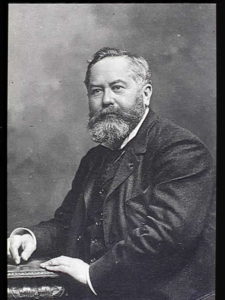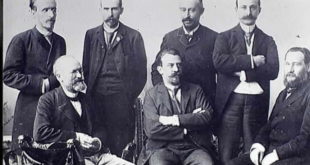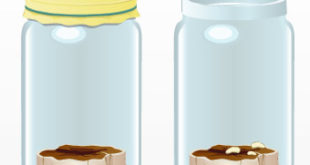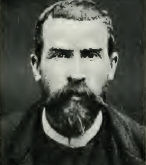
Born in Chilly-le-Vignoble (Franche-Comté Province) to a schoolteacher and a housewife, Charles’ education was well provisioned. He attended the lycée Rouget-de-l’Isle de Lons-le-Saunier. This is when he settled on Mathematics and Science. Rural towns would most often raise their sons to tend the fields and the flocks, but if they were destined for academics, these bachelors were sent to Paris, or some other large city. It was also customary for the Comtois to help one another in these arrangements. Thus Chamberland was sent to Paris to attend the Collège Rollin, where he specialized in Mathematics from 1871 to 1874. He prepared for entrance into the Grandes Écoles. When he passed the exams of the École Polytechnique and the École Normale, he chose the latter for his aggregation. He took a degree in Physical Science in 1875 and was immediately assigned to teach at the Lycée de Nîmes. During this assignment he requested help from his schoolmaster back in the Jura, to see if better accommodations could be provided for him in Paris. This former teacher contacted Louis Pasteur, a fellow Comtois, and arrangements were made for Chamberland to come back to the École Normale as curator of Pasteur’s laboratory. He had a love of technical devices and Pasteur could see the innovator in him.
Chamberland and Spontaneous Generation
During these years at the Rue d’Ulm, Pasteur was engaged in a dispute with Dr. Bastian, an Englishman who claimed that Pasteur’s experiments on spontaneous generation were invalid. Pasteur believed that every illness was attributed to a specific germ and his experiments centered on isolating and nurturing these germs and conversely, creating a sterile environment, deprived of oxygen, so that germs could not thrive. The issue between him and Dr. Bastian was that of interiority versus exteriority; meaning, that maladies and fermentations were caused internally, as a natural process of decay, or, as Pasteur insisted, that all such ferments were caused by an external germ. So Pasteur instructed Chamberland to figure out what had gone wrong with the experiment of Dr. Bastian. The Englishman had the good sense to report in detail how he had carried out the investigation of boiled urine, in sterile instruments and exposed to pure air. Chamberland scrutinized every aspect and discovered that in acidic solutions, germs were not killed, but merely rendered inert. It was known that very high acidity was hostile toward germs, but it was also the case that an alkaline environment was deadly to germs. Dr. Bastian neutralized the urine with potash, a basic substance which Pasteur reasoned would have killed any life in the solution. By neutralizing the urine, it opened the field to the germs, which populated rapidly in the laboratory of Dr. Bastian. Beside this issue of the reaction of a chemical solution, Chamberland exposed the other flaw in the experiment: the temperature at which Pasteur sterilized his instruments was insufficient to kill all germs. The standard for Pasteur was 100°C, otherwise called “the boiling point.” But according to Chamberland, certain germs could withstand this temperature in excess of 10 or 20 degrees beyond that point. This explained why Dr. Bastian’s experiments ran contrary to those of Pasteur.
Proper Sterilization Techniques
Following these researches, Chamberland also showed that when boiling a solution in a flask, only the submerged parts were free of germs. To sterilize the walls of the flask, the entire flask must be heated to 180°C. One final fact remained to settle the debate: the pure air which seemed to rejuvenate the sterile solution. Heated air was thought to be free of germs. Pasteur had investigated the effect of air on fermentations, and he knew that yeast thrived on oxygen, but it was now clear that oxygen was a vital nutrient to all germs, and thus to all life at the microscopic level. According to Duclaux, Dr. Bastian served a useful role in debating Pasteur, unlike most of his critics, because this was a very important step in perfecting the theory of germs, which, in the end, negated interiority. Since 1860, Pasteur had been espousing the idea of germs, but it was thanks to the ingenuity of Chamberland that Pasteur perfected his understanding. When Pasteur officially published his theory in 1876, he referenced his assistant Chamberland for his contribution.
In addition to the autoclave, another important contribution to the laboratory of Pasteur was Chamberland’s filter. Until the mid 1870s, Pasteur suspected the air alone as the vehicle for germs, but now, all water, no matter how pure, was shown to contain microscopic germs. Ceramic and brick filters had been used in those days, as well as various washes, to distill water. But Chamberland reasoned that some bacteria were able to slip through the pores and thus a more precise filter was needed. He patented a porcelain filter which could easily be fixed to a kitchen faucet. This was widely produced and significantly improved the sanitation of drinking water such that Chamberland was literally a household name.
Investigation of Splenic Fever
Before his apprenticeship was up, Pasteur had another assignment for Chamberland. He was deployed with Dr. Roux to the vicinity of Chartres where charbon had broken out amongst the livestock. This fatal illness was also called splenic fever, because it caused an inflammation of the spleen. The epidemic had been brought to Pasteur’s attention by a knacker, whose carcasses had black veins and dark spots everywhere. The apprentices went to the countryside to collect blood from the fallen. “Seek the microbe” Pasteur instructed them. The microbe was found; it was the same as had been identified by the German, Robert Koch, who named it bacillus anthracis, or anthrax. During these researches the coterie of the Rue d’Ulm investigated chicken cholera as well. Pasteur was attempting to vaccinate hens with the isolated bacillus of cholera in the manner that the Englishman, Jenner, had done nearly a century before. There was no success in this method and Pasteur thought to himself that Nature was too secretive to make all bacteria alike. At a certain point Pasteur departed on one of his usual working vacations and he left instructions for Chamberland to inject the infected blood into a test group of chickens. But Chamberland had a vacation of his own and delayed the vaccination until his return a month later. When he inoculated the hens they fell ill, but eventually recovered. Chamberland thought that a mistake had been made and was on the verge of throwing out the toxic blood when Pasteur stopped him, thinking that perhaps the bacteria had become weakened. This was in fact the key to immunization, and as Pasteur often said, “Chance favors the prepared mind.” By this stroke of luck, Pasteur realized that virulent diseases attenuated to the point where they no longer posed a lethal threat. This “vaccine” could be used to build the body’s resistance to the virulent form. Together, Pasteur, Chamberland and Roux inoculated countless chickens and defeated the cholera. This opened the door for finding a method of attenuation of anthrax. Chamberland devised a method of attenuation through the mixture of bichromate of potassium, while Pasteur clung to his oxidization of the virulent strain. The results favored Chamberland, and on the occasion of Pasteur’s famous demonstration at Pouilly-le-Fort, he used Chamberland’s method to prepare the anthrax vaccine.
The results were arranged in a paper on attenuation of the anthrax virus which Pasteur read to the Academie des Sciences. He named the assistants Chamberland and Roux for their indispensable contributions. The two had traveled the countryside, inoculating hundreds of sheep a day – Chamberland was solely responsible for preparing the vaccines, while Roux made the injections. When the Republican government wanted to reward Pasteur in 1878, for delivering the livestock from this terrible epidemic, he would not assent unless his two assistants were recognized as well. France awarded its highest honor to Pasteur, the Grand Cross of the Legion of Honor. Chamberland and Roux received the red ribbon: Knight of the Legion of Honor.
Chamberland’s Career
After these breakthroughs, Chamberland was appointed Assistant Director of the Rue d’Ulm, allowing him to remain with Pasteur for many more years. He continued to prepare vaccinations of cholera, anthrax and swine measles, which reduced fatalities to less than 1% in France and saved the economy more than 5 million francs. For the first time in history, vaccines were produced en masse, with government funds behind it. Chamberland established a separate laboratory to keep up with all the work. This annex to the Pasteur laboratory was located nearby on the Rue Vauquelin. This was the advent of the Scientific Method. Pasteur’s techniques of asepsis, antisepsis and pathology, were largely based on the work of Messieurs Joubert, Chamberland and Roux.
In 1883, Chamberland was made an honorary member of the Société de Biologie. His water filter was immensely valuable in stopping the typhoid epidemic of 1884. This filter was later used by fellow Pasteurians to discover the diphtheria and tetanus toxins. In 1885 he was elected to the Chamber of Deputies on the Republican side. He used this position to read numerous reports on public health. He also succeeded in legislating mandatory vaccination of children. In 1887 he was elected to the city council of his home town, and later elevated to mayor.
At the inauguration of the Pasteur Institute, Chamberland was given an entire wing of the building from which to oversee applied bacteriology. From this laboratory, he attempted immunizations from chemical products rather than attenuation. His peer Émile Duclaux appointed him co-editor of the official publication of the Institute. Following the death of Pasteur in 1895, Chamberland and Roux became sub-directors of the Institute, under Duclaux. Ten years later, after the death of Duclaux, the two were elected co-directors. Later that same year, Chamberland succumbed to a chronic illness.
 Pasteur Brewing Louis Pasteur – Science, Health, and Brewing
Pasteur Brewing Louis Pasteur – Science, Health, and Brewing 

